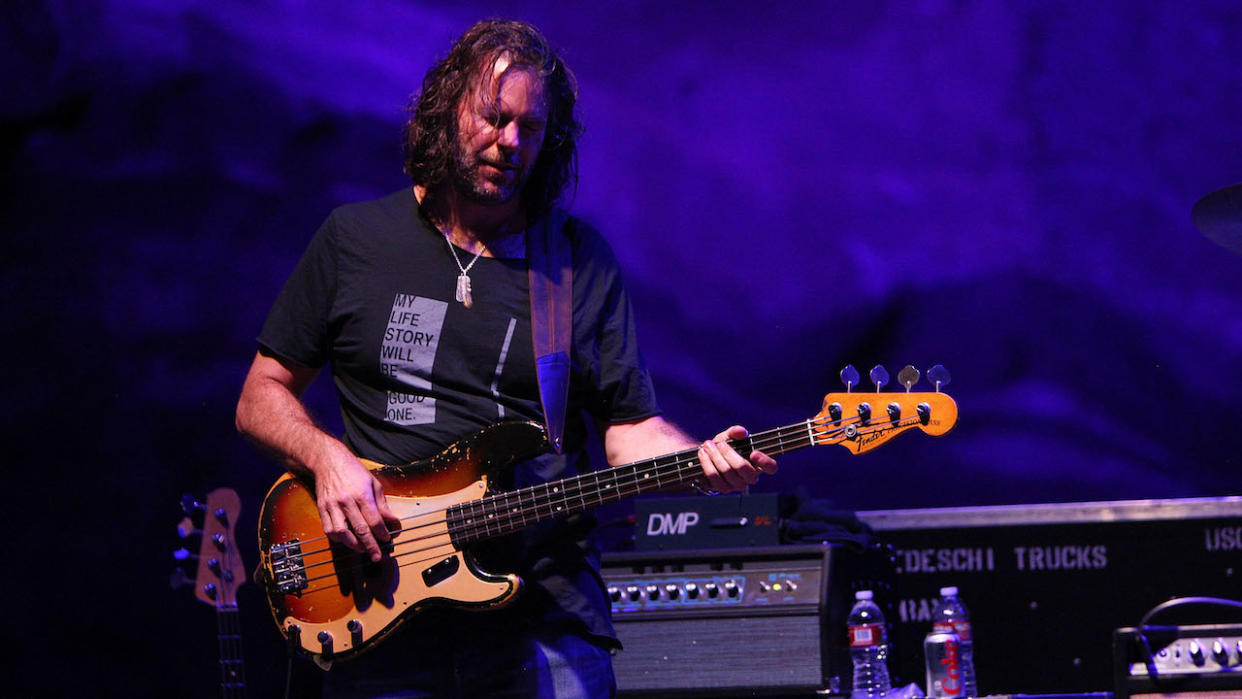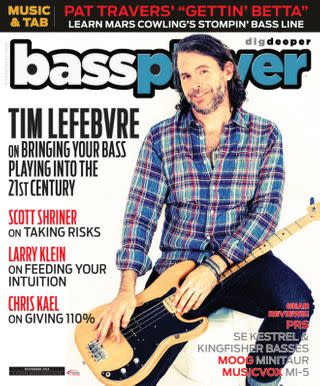“The higher up you wear your bass, the more it makes you think about what you’re playing. I don’t want to think that much”: Tim Lefebvre explains the belt-level placement of his low-slung P-Bass

- Oops!Something went wrong.Please try again later.
The visual for one of the hippest bassists on the scene is simple: 6’4”, with a low-slung, flatwound-strung P-Bass. Asked about the belt-level placement of his bass, Tim Lefebvre offers, “The higher up you wear it, the more it makes you think about what you're playing. I don't want to think that much.”
Thanks to his laid back demeanour, and a fearless improvisational sense, Lefebvre has become the bass player everyone wants to work with. His mastery of effects pedals has also earned him hero status among working thumpers.
Born in Foxboro, Massachusetts, Lefebvre grew up in a musical family. Guided by his brother's interest in jazz, he joined his high school jazz band, while gathering the influences of Darryl Jones, Victor Bailey, and Marcus Miller. He also took on upright bass, with Paul Chambers and Charlie Haden in his ears.
Heeding the advice of drummer Zach Danziger, Lefebvre moved to New York City in 1993, working as an office manager before cracking the scene with Chuck Loeb, Leni Stern and Bill Evans. His reputation as a versatile doubler ran wild, leading to TV dates on Saturday Night Live, stints with everyone from John Mayer to Elvis Costello, and an endless stream of genre-altering recordings by the likes of Wayne Krantz, Rudder, Uri Caine, and Donny McCaslin.
Relocating to Los Angeles in 2011 for a recharge, Lefebvre found that his plucking past preceded him, and he was quickly enlisted for live gigs and soundtrack dates. He also joined the procession of bassists who served as road and studio replacements for Oteil Burbridge in the Tedeschi Trucks Band, making a deep enough impression that he was invited to join as a full-time member. That's where we begin our wide ranging conversation.
The following interview from the BP archives took place in November 2014.

How did you get the gig with Tedeschi Trucks?
“I came on their radar through the recommendation of John Leventhal. He writes with TTB – and also from having jammed with drummer J.J. Johnson. I don't come from the Southern rock or jam-based tradition. I just try to keep it moving forward. The split between song and improvisation is about 70/30, so I have plenty of freedom to add my own touch to the music. And there's a point every show, in Bound for Glory, during Kofi Burbridge's organ solo, where he and I bounce off each other and take it as far out as we want.”
How about the two-drummer aspect?
“J.J. and Falcon (Tyler Greenwell) play super-creatively together, and have a great time feel, so it's like having a big pillow to sit on all night. I tend to play a little on top or right on the beat, and those guys sit back a little, so it was really valuable for me in learning to play on the back side of the beat. What's cool is our front-of-house mixer has a mic on my rig for board recordings. So instead of the dreaded DI/no-EQ sound, I get a nice, wide amp sound that better represents where I played the notes and how they fit into the overall picture. The other element of the two-drummer line up is that it's often associated with the Allman Brothers, leading to expectations of long jams, but we're more of a song band.”
Let's turn to your improvisational side. Would you trace much of your growth and development in that area to your time with Wayne Krantz?
“Actually, the first person to plant the risk taking seed in me was Jaco Pastorius. I listened to him a lot early on, but it was with Wayne that it all came together for me. His message was, ‘strive to play originally, at all times,’ and when that comes from someone who plays completely outside the box, it has a huge impact. The peak for me came when Keith Carlock joined. Keith was breaking new ground on drums; he was like a freight train. Some of the heaviest musical experiences of my life came in that band. Wayne instilled in me the confidence and ability to improvise in any context.”
How did you get interested in electronic music?
“Zach Danziger turned me onto it in the ‘90s, and I first got to play it with him and with drummer Jojo Mayer. I was into the bass-heavy sounds of artists like Dillinja. and Grooverider, and I got the atmospheric side from artists like Photek, Plug, Squarepusher and Karsh Kale. What caught my ear was that the basslines were static, but they would evolve sonically – with filters opening and closing, distortion added, and so on. I view electronic music with a song sensibility; It's just a different kind of statement than the usual verse and chorus. It's about having a good melody and a good beat, to keep people dancing.”
How would you describe your role on Mark Guiliana's Beat Music?
“Mark is one of the most creative musicians I know: thoughtful and fresh-sounding in any genre. He has taken the live electronica concept to an exciting new place. That album is improvised electronic music played entirely in real time, with no loops or overdubs. My approach was to provide a bassline that would support and enhance the music, and to change it up gradually, both sonically, via effects, and by altering the line. I would react to what was going on by asking myself, ‘What would the bass be doing on an electronica track right now?’ Another trick I use, when the performance turns overly electronic, is to bring in clean bass, playing retro R&B grooves, or I'll grab a pick and play a Beach Boys-style bassline – like the way DJs drop in old school samples and beats.”
What are the keys to becoming fluent in multiple styles?
“For me, it starts with motivation and preparation. I'm always nervous that I'm going to suck, so I bring my ‘A’ game every time. I learn the music thoroughly before coming to the gig or session. Genre-wise, I may not get the exact notes and tone, but I'm pretty good at capturing the intent of the music and getting to the essence of the feel, even with limited exposure to it. For example, I don't come from a Willie Weeks bag, but having been fortunate to meet him and watch him play and just own it, that rubbed off on me and comes out in my playing when called for.”
What's your approach on a session?
“Generally, I like to thread together the chord changes with my part, to provide a sort of counterpoint to the melody. I try to make my line climb or descend at some point, to add motion and make something musical happen. Producers and artists usually want that in some form. And then there's the sonic side: finding the right bass for the track. In that way, I fit in well in L.A. because we bassists are all going to play somewhat similarly, on a given song, so the sound factor becomes a key – even after manipulation of tracks that's so common now.”
What was your initial attraction to effects?
“I started out with an octaver pedal, after hearing Darryl Jones use one during Sting’s Consider Me Gone. It blew my mind: he kicked it on and without playing anything different, he enhanced the music dramatically. I'm mostly into effects for the sonic aesthetic – to drive the music and make it a little more exciting without the crowd really knowing why, as opposed to using effects as a soloing tool. My two main colors are an octave pedal and some kind of overdrive.”
How do you get your signature, dubby ‘808’ sound?
“Jojo Mayer first encouraged me to do it. I was hearing it on dance records and I wondered how to get that sound. What I found, on my Boss OC-2, was if I turned off the Octave 2 and Direct Level knobs, and turned Octave 1 almost all the way up, I got something close to that dancehall-reggae ‘808’ tone. 3Leaf Audio made me a custom ‘Octabvre’ box with a ‘sub’ solo button, so I can get my 808 sound without having to bend over and turn knobs. It has the sine wave of the OC-2 and the Mu-Tron Octave Divider.”
How did you hook up with electronica duo Knower?
“Louis Cole is a fan of Wayne Krantz and Rudder – you can hear the influence of Keith Carlock and Nate Wood in his drumming – so when I moved to L.A. he asked me to do some gigs with him and Genevieve Artadi. I dug their music, which is pretty forward-thinking, and they were kind enough to have me on some tracks. Louis is a great drummer, and he has an amazing feel and unique sound on keyboards and keyboard bass. The challenge with many web-minded artists like Knower is that video footage of the song being recorded is part of the equation. That meant cutting the ‘Lady Gaga’ medley – a very tricky bass part that Louis wrote – took two hours to film, even though it was only 16 bars long.”
What's the state of your upright playing?
“I've been practicing and recording a lot, and getting together with players like Linda Oh and Larry Grenadier in New York, and David Piltch and Michael Valerio in L.A. They all have so much command and such big sounds that they make the instrument as powerful as the bass guitar. Beyond the notes, they have the conceptual side together, which is what I strive for. I’m finally getting to the point where I can be creative on the upright, instead of just being functional. I'm able to use the same toolbox I draw from on bass guitar.”
You're also known for your “broken lines” approach. Can you explain it?
“The root of it was D'Angelo's Voodoo album, with Pino Palladino, who's my favourite bassist. I was aware of Pino's great ‘80s and ‘90s pop output, but this was an earthquake album for me. I first got to apply the same vibe on a Till Bronner track called Oscar Said. For it to work, there has to be someone in the rhythm section referencing metronomic time. A good way to develop it is by playing it to a click and messing with the eighth-note after the downbeat; lag it so it's almost a triplet. From there you can experiment with taking a phrase and stretching it within the bar line, or even across the bar line; maybe delay the first part of a phrase and finish it in a flurry, or vice versa. Eventually you'll become comfortable playing freely within a given space.”
What can you offer about your transition between New York and L.A.?
“After 18 years in New York, I felt like I needed a change of scenery. Once I fell out of the rotation at Saturday Night Live, there was no steady work to keep me there. Some New York friends had moved to L.A. and done well, so I came out, and fortunately I'd made enough connections that work happened right away. What's different from New York is there's more of an industry in L.A. There's more business going on, which means there's always the potential for something to happen – people are always looking for material, which is good from the writing side. There’s also a more concentrated amount of super-talented players. I met a slew of great pop/rock textural guitarists, for example. Of course the weather and quality of life are hard to beat, as well.”

